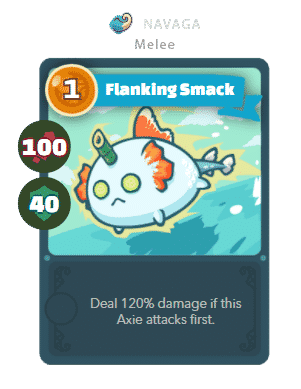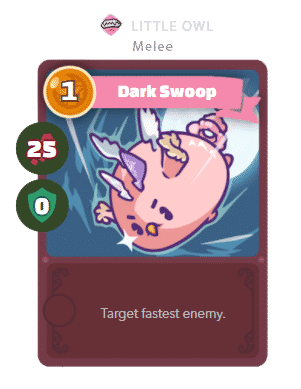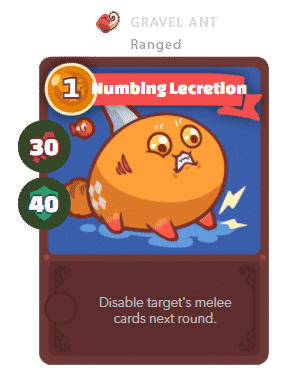“Strategy without tactics is the slowest route to victory. Tactics without strategy is the noise before defeat.”
-Sun Tzu
Like any other strategy card game, winning a battle in Axie Infinity requires immense planning and near-perfect, if not flawless, execution.
The arena is a highly competitive battleground where players duke it out and fight for SLP and MMR, and in order to consistently win matches, you must put in the effort to gain a deeper understanding of the game’s mechanics.
However, before I dive into the inner workings of player vs player (PvP) combat, you should know about the elements in the battle heads-up display (HUD).
Jump to:
Battle HUD
The battle HUD consists of the following:
- Name of the Opponent
- Round Count – keeps count of the current round. Its importance lies in taking note of buffs, debuffs, and other card effects. In the current event “Bloodmoon Rising,” Axies will take damage that increases after every round starting at Round 10.
- Turn Order – the order in which Axies can play their moves; based on an Axie’s Speed.
- Opponent Cards Left/ Available Last Turn – this one is a little more tricky. At the end of your turn and the start of the battle in that round, it displays how many cards are at your opponent’s disposal. After the battle has resolved and the next round starts, it displays how many cards your opponent has left from the previous round.
- Options – houses the surrender button (only available after round 5).
- Axie Class – displays the class of the Axie.
| Axie Class Icons | Axie Class |
| Aqua | |
| Beast | |
| | Bird |
| Bug | |
| Dawn | |
| Dusk | |
| Mech | |
| Plant | |
| Reptile |
- Health Points (HP) – the amount of health an Axie has. Axies die if it hits 0.
- Enemy Axies – Axies you need to take down in order to gain SLP.
- Battle Energy – the energy used to activate cards and play moves; start with 3 and gain 2 after every round.
- Card Deck – The number of cards you have in your deck and hand. Refreshes if it hits 0.
- Axie Cards – the cards that let Axies attack, defend, and play other effects.
- Turn Number – indicates the order in which your Axie will be able to move.
- Discard Pile – keeps count of the cards you have used/discarded.
- End Turn Button – ends your turn and starts the battle phase.
Combat System
Axie infinity’s combat system is easy to learn but requires tons of research and experience to reach mastery. In this article, I’ve split it into two categories: Basic and Advanced.
Basic Combat
Under basic combat, we’ll discuss basic concepts like battle formation, how turns work, offense, defense, buffs/debuffs, and card combos.
Battle Formation
Before you start participating in battles, you first need to create a team of Axies and arrange their formation.
If you haven’t bought your starting Axies yet, I suggest reading our article on how to choose starter Axies here:
How To Choose Your Starter Axies
A team of Axies usually consists of 3 Axies that have respective roles reminiscent of traditional RPGs such as tank, support, and damage dealer. They are usually formed with the damage dealer at the back, the support/secondary damage dealer in the middle, and the tank right in the front.
This is the standard formation because Axies target the enemy Axie in front of them. However, there have been successful teams in the arena that do not follow this format, so it’s best to figure out what playstyle works for you.
It’s also a good idea to either pick the top or bottom 2 slots for the backline and midline Axie. This formation helps you prioritize targets better, in the case the enemy splits their frontline between two Axies.
Turns
Like any other card game, you take turns playing cards in order to defeat your opponents using superior strategy and tactics. In Axie Infinity, the first round begins by giving you three (3) starting energy and six (6) cards. After every round, you get two (2) additional energy and three (3) cards. In order to play cards, you must have the energy needed to activate them.
Keep in mind that in PvP, you only have a finite amount of time to decide before your turn ends; about 30 seconds. Adventure is more lenient and gives you more time. There is also a limit on the number of cards that can be in your hand at a given time, so the game will prompt you to discard some if you have more than the maximum.
Attacking
Attacking is straightforward. You play a card and you deal the damage indicated in the card, plus bonuses/penalties if there are any. Although there are several computations and formulas that come into play in order to arrive at the most accurate damage values. I’ll get more into that later.
All Axies have offensive moves, albeit varying in damage, effects, and conditions. For example, the Aqua card “Flanking Smack” has 100 damage, but it deals 20% more if the Axie attacks first.

There is a chance for your attack to deal more damage based on the Axie’s Morale; the higher it is, the more likely you can do what’s called a “critical strike.”
It’s also important to take note that you’ll be attacking the enemy Axie directly in front unless you have cards that can prioritize targets or the battle formation of your opponent is not linear. I’ll get more into that in the Advanced Combat part of the article.
Defending
Defense is similar to attacking, but instead of dealing damage, you gain shields that help mitigate your opponent’s attacks. Bonuses are also applied to shields.

The basic concept of defense in the game is shielding your Axies in order to prevent the enemy Axie from taking them out. A great example of a shield card can be found in the Plant class: October Treat. You can also heal your Axie instead of shielding, but it is considered riskier because your Axie might get blown up before they get the chance to move.
Buffs/Debuffs
Buffs and debuffs also exist in the game. Buffs aid your Axie by providing boosts and support to your team, while debuffs can weaken the ranks of your opponent. Cards like “Upstream Swim” and “Nile Strike” are examples of cards that affect the speed of Axies.


A more advanced guide to buffs and debuffs can be found in this article:
Combos
Card Combos are an integral part of combat. Since you only have a limited amount of time and resources to work with, playing cards in the correct order ensures that you are maximizing your available energy, while fighting against your opponent.
This is also where your Axie’s skill stat comes into play. The higher an Axie’s Skill stat, the more damage your combos deal. Combo damage can be calculated with the formula: (Attack * Skill) / 500
A good example of a high damage card combo are the cards in the Beast class: “Single Combat,” “Nut Throw,” and “Nut Crack.” You could also replace the two “Nut Cracker” cards with either two “Ivory Stab” cards or another Single Combat with one Ivory Stab for energy gain.



The order in which you play your cards is also important because there are effects that are only useful if they are played in a specific order. For example, the Bug cards “Buzzing Wind” and “Allergic Reaction” have susceptible damage outputs if they are played wrong.


Allergic Reaction deals 30% more damage if the enemy has a debuff, so it’s better if you play Buzzing Wind to debuff the target Axie with Fragile first in order to maximize your damage.
Advanced Combat
Under advanced combat, we’ll be taking a look at how basic concepts could be further improved, as well as introducing new mechanics that you can implement in your next matches that will surely step your PvP game up.
Class Advantage
There are advantages and disadvantages that each class has over the other. First, let’s go over the class advantages, as well as their primary, and secondary attributes.
| Class | HP | Skill | Speed | Morale | Attributes (per part) |
| Aqua | 39 | 39 | 35 | 27 | +3 Speed, +1 HP |
| Beast | 31 | 35 | 31 | 43 | +3 Morale, +1 Speed |
| Bird | 27 | 43 | 35 | 35 | +3 Speed, +1 Morale |
| Bug | 35 | 31 | 35 | 39 | +3 Morale, +1 HP |
| Plant | 61 | 31 | 31 | 41 | +3 HP, +1 Morale |
| Reptile | 39 | 35 | 31 | 35 | +3 HP, +1 Speed |
As you can see from the table, each class has an attribute they specialize in and another where they have a minor advantage. Secret classes such as Mech, Dawn, and Dusk, on the other hand, do not have their own parts and cards. However, they have different base stats and the following bonuses:
| Class | HP | Skill | Speed | Morale | Attributes (per part) |
| Dawn | 35 | 35 | 39 | 31 | 7.5% class bonus for Bird & Aquatic cards |
| Dusk | 43 | 39 | 27 | 31 | 7.5% class bonus for Reptile & Plant cards |
| Mech | 31 | 39 | 43 | 27 | 7.5% class bonus for Beast & Bug cards |
These class advantages manifest in the form of a 10% damage & shield boost when they use cards of the same class, a 15% damage bonus on Axies they are strong against, or a 15% damage penalty on Axies that are strong against them. These multipliers can also stack.
Here is the RPS analogy graphic of class advantages

For example, a Beast Axie that uses a Beast move against a Plant Axie will enjoy a total of 25% damage boost (excluding bonus damage from combos and card chaining), while a Plant Axie that uses a Reptile move against a Bug Axie will deal 15% less base damage.
In case you’re interested in secret Axie classes as mentioned a while ago, you can check them out here:
Axie Infinity: What Are Secret Axie Classes?
Advanced Attacking
A certain level of prediction and pattern recognition is required here. In order to get a clearer picture of the battlefield, one must take these little snippets of information provided by the game and put them together. In doing so, you can elevate your gameplay to astounding levels.
There are several ways you can evolve your attacking patterns and offensive techniques. Namely, they are prioritization, baiting, and damage calculation.
Prioritization
There are Axies that are capable of bypassing the enemy frontline, directly attacking the Axies taking cover at the back. The Bird class is a great example of an Axie that can prioritize targets. Moves like “Dark Swoop” and “Smart Shot” have target prioritization that is used to immediately take out the backline without bothering with the tankier Axies.


The Aqua, Beast, Plant, and Reptile classes also have cards that can prioritize targets. Debuffs like Stench also help in target prioritization, because Axies avoid attacking enemies that smell bad.
Baiting
You can also trick enemies into thinking you are going to do a specific action, when in fact, you are going to do something else.
Also known as misdirection, baiting enemies requires a high level of understanding when it comes to game mechanics, as well as your opponent’s attack, and defense patterns. If you recognize certain patterns or understand how your opponent thinks and moves, you can play around their decisions and take advantage of their predictability.
Unfortunately, this technique is not always accurate and will probably fail from time to time. Weigh the possible risks of your decision and act accordingly to what you think would be most beneficial. Although you can probably sharpen your game sense to great heights, don’t be discouraged when your plan doesn’t work.
Offensive Damage Calculation
Calculating your damage output is a great way to maximize energy and card resources. If you can effectively calculate the damage you deal, you can efficiently take down the enemy Axies without playing unnecessary cards.
Taking note of enemy cards, as well as the maximum shield they can put up in a single turn will prevent their Axies from countering your attack.
Predicting when your opponent might put down either a small shield or build a brick wall around their Axies is also important so you don’t waste your energy, cards, and damage.
It helps to have something you can write on, as well as a calculator next to you so you can keep track of all the computations you’ll be doing.
Advanced Defending
Lockdown
Some people say that the best defense is a great offense. With that in mind, if your opponent cannot use their cards in retaliation, you can be the unstoppable force while also being the immovable object at the same time.
Bugs are experts in disrupting the flow of enemy attacks. With moves such as “Numbing Lecretion,” “Sticky Goo,” and “Anesthetic Bait,” they can prevent the opponent from effectively dishing out combos (while being a HUGE nuisance at the same time).


Reptiles can put up a great wall of defense and even reflect some damage back to their attackers. Cards like “Bulkwark,” “Tiny Catapult,” “Critical Escape,” and “Jar Barrage” ensure that your Reptile will get to live another day.
Prevention
An ounce of prevention is better than a pound of cure. Bird and Bug Axies seem to agree since they can prevent the opponent from taking action.
The Bird card “Balloon Pop” and Bug cards “Terror Chomp,” “Third Glance,” and “Sunder Claw” prevents attacks from landing with the Fear debuff, as well as forces them to throw away cards from their hand.

Prevention cards like these are lethal, especially Terror Chomp. Their ability to lock moves increased their meta popularity, especially in the rank ceiling.
Defensive Damage Calculation
Defensive damage calculation follows the same principle with its offensive counterpart, only this time, you calculate the amount of shields you get and compare it to the maximum damage your opponent can deal.
There may also be times that even if you put all your energy into shielding a single Axie, they could still be taken out, so calculating helps you decide whether to put up the iron curtain, or save the energy, take it on the chin, and avenge your fallen comrade instead.
Card Chaining
Card chaining is what happens when 2 or more Axies play cards with the same class in the same round.
Their cards gain a bonus of around 5-6%, and an Axie’s body (class) has no significance when it comes to card chains, meaning that a Reptile and Bug Axie that both play a plant card in the same round gains this bonus.
Counting Energy
Keeping count of your opponent’s energy is HIGHLY important. It lets you keep track of how many moves they can make, which translates into either how much damage they can deal or shields they can put up.
There are many ways you can use in order to effectively count how much energy they have stored. You can try using pen and paper, your finger, or even just your brain if you’re confident in your brainpower. Whatever your method may be, as long as you can remember, you’re good to go.
Learn more about how to use Axie Infinity energy here:
How To Effectively Use Energy in Axie Infinity
Summary of Tips and Tricks
- Pick the most suitable formation for your team
- Remember that you get 3 energy and 6 cards at the start of round 1, and 2 energy and 3 cards thereafter
- Don’t underestimate the power of buffs and debuffs
- Choose the correct combo and card order based on your and your opponent’s cards
- Remember class advantages. Keep a chart handy just in case you forget
- Be wary of Axies with target prioritization
- Don’t be afraid to take risks, but don’t take too much
- Take Stuns and other debuffs into consideration when you combo
- Keep a pen and some paper or a calculator nearby
- Count your opponent’s energy and cards
What do YOU think about this PvP guide? Did I miss anything? Comment it down below! Don’t forget to check our related articles!
Related Posts

Troubleshooting Performance & Technical Issues in Axie Infinity
Have you experienced issues and errors when playing Axie Infinity? Most of the time, a quick restart of the game

How to Make a Resume for Axie Infinity
You’ve probably seen quite a few of these resumes for Axie Infinity scattered across the internet. Forums, Facebook groups, and

How to Use a Hardware Wallet with Axie Infinity
So, you’re trying to up your crypto security huh? A wise choice! Dealing with cryptocurrency can be a tedious, albeit

